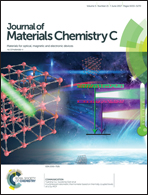Efficient solution-processed red all-fluorescent organic light-emitting diodes employing thermally activated delayed fluorescence materials as assistant hosts: molecular design strategy and exciton dynamic analysis†
Abstract
The strategy of employing highly soluble, thermally activated, delayed fluorescence (TADF) materials that possess small singlet–triplet splitting energies (ΔEST) for efficient reverse intersystem crossing (RISC) processes results in simplified and low-cost solution-processed all-fluorescence organic light-emitting diodes (OLEDs). However, confined by the energy gap law, it is difficult to strike a balance between a large singlet radiative rate constant (kSr) and very small electron exchange energy (J), which hinders the realization of highly efficient red TADF emission with short excited state lifetimes. Herein, via integrating assistant hosts with TADF character and conventional fluorescent dopants with a large kSr, efficient solution-processed red all-fluorescent OLEDs with external quantum efficiency exceeding the theoretical maximum for traditional fluorescent devices (5%) were prepared. Exciton dynamic studies of the ternary system revealed that the rapid Förster energy transfer channel enabled the significant reduction of singlet and triplet exciton density, which contributed to the suppressed efficiency roll-off of OLEDs operating at high current density. Regarding TADF assistant host molecular design, maintaining a moderate kSr for a large Förster energy transfer radius is as important as keeping a relatively small ΔEST for efficient triplet exciton utilization in this ternary prototype.



 Please wait while we load your content...
Please wait while we load your content...